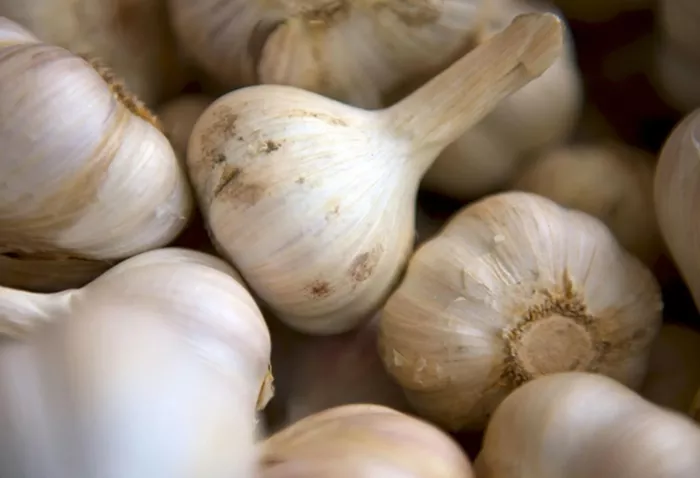According to experts, garlic should be planted between October 1 and November 15. This timing gives the cloves an opportunity to develop roots before going dormant for the winter months. When planting, separate the cloves from the bulb and place them root side down (pointed side up) about 2-4 inches deep. Space them 6-8 inches apart in the row and leave 12-18 inches between rows. A bulb planter, often used for tulips and daffodils, is a handy tool to plant cloves quickly. When the ground starts to freeze in November, cover the bed with 6-12 inches of straw to insulate the cloves.
Unlike the fast-paced planting of spring and summer crops, garlic planting is a more relaxed activity. By the time garlic is sown, the garden is mostly cleared. Crop debris is removed, composted, and cover crops are sown to protect the soil during winter. The cooler autumn weather makes planting garlic a peaceful task, fitting perfectly into the fall season’s gentle light and cooler air.
A Carefree Crop
Garlic is a relatively easy crop to grow. Its strong flavor and pungent aroma, while delicious in sauces, also serve as a natural defense against pests. Unlike other crops, which require constant monitoring to prevent damage from wildlife, garlic tends to be left alone.
However, garlic does have specific soil fertility requirements. In early spring, I applied nitrogen-rich blood meal and potassium-rich langbeinite, as suggested by a soil test. Unfortunately, I did not enrich the soil before planting or apply nitrogen again in May as recommended, resulting in smaller garlic heads at harvest time in July.
Maintaining Moisture
Beyond soil fertility, garlic’s only major need is proper moisture management. It thrives in well-drained soil, much like other bulb crops. However, during dry spells in its growing season, particularly in spring and summer, deep watering at least once a week is essential to support its growth.
Enjoying the Garlic Scapes
A bonus of growing garlic is the scapes, the flower stalks that emerge in June. For years, I would snip them off to prevent the plant from diverting energy to seed production. But thanks to my Asian friends, I learned how tender and sweet these scapes are when tossed into a stir-fry, adding yet another delightful use for the garlic plant.
Choosing Your Garlic Variety
When buying seed garlic—bulbs you separate into cloves for planting—you’ll encounter many varieties. The most significant distinction is between “softneck” and “hardneck” types. Hardneck garlics, as the name suggests, have a stiff central stem, while softnecks have more flexible stems. Hardnecks are better suited to colder climates and often have a spicier flavor. They are more challenging to braid for storage, but my wife, skilled in braiding from her childhood, manages to create neat garlic braids once the bulbs have dried for a week or two. The best time to harvest is when the plant’s leaves turn yellow or brown, indicating that the bulbs are mature.
Seed Garlic: Buy or Save?
I usually buy new seed garlic each year from online suppliers that offer disease-free, organically grown cultivars. Some gardeners prefer to save the biggest bulbs from the previous year’s harvest to replant. While some claim that this can eventually lead to garlic varieties adapted to their local conditions, this isn’t scientifically accurate. Garlic grown from cloves is genetically identical to the parent plant, so it does not evolve over time. Nonetheless, growing garlic from saved bulbs remains a satisfying and cost-effective method for many gardeners.
In the end, homegrown garlic provides significant benefits, from its robust flavor to its versatility in the kitchen and garden. Whether you’re planting new bulbs or saving last year’s crop, garlic remains one of the most rewarding crops to cultivate.
Garlic Planting Tips from the UMASS Center for Agriculture, Food and Environment
Plant garlic between October 1 and November 15 to allow roots to establish before winter dormancy.
Separate cloves from the bulb, planting them root side down (pointed side up) 2-4 inches deep.
Space cloves 6-8 inches apart in the row and 12-18 inches between rows.
Use a bulb planter for quick planting.
Mulch the bed with 6-12 inches of straw when the ground begins to freeze in November.
Related topics:
- Minocqua Florist Spreads Joy by Giving Out Flowers in ‘Petal It Forward’ Initiative
- Mohican Flowers Participates in Nationwide ‘Petal It Forward’ Campaign
- A Vibrant Floral Celebration at the Kenya Flower Festival


